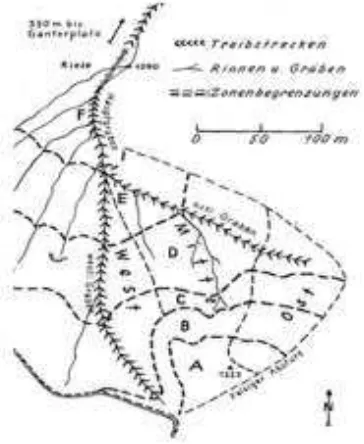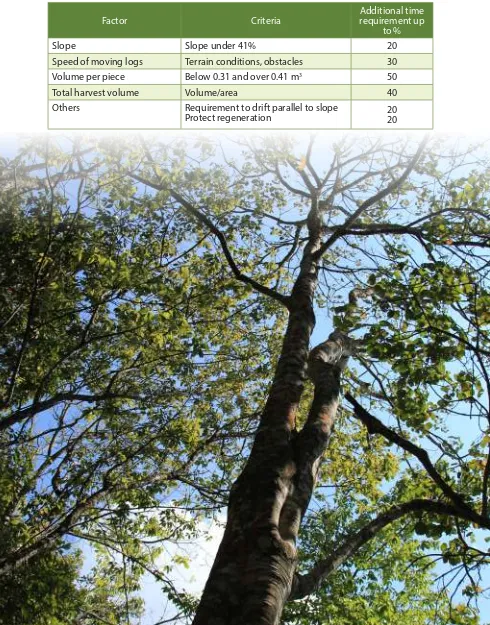Manual downhill drifting
RECOFTC - The Center for People and Forests
Copyright © RECOFTC December 2015 Bangkok, Thailand
All photos courtesy of RECOFTC except where reference is indicated
Reproduction of this publication for educational or other non-commercial purposes is authorized without prior written permission from the copyright holders provided the source is fully acknowledged. Reproduction of this publication for resale or other commercial purposes is prohibited without written permission of the copyright holder.
This publication has been generously funded by the Ministry for Foreign Afairs of Finland. The views expressed in this publication are those of the authors and do not necessarily relect the views of RECOFTC and our donor organizations.
Table of contents
1. Introduction
1
2. Downhill drifting
3
3. Conclusions
9
References
10
Figures
Figure 1. The sappie – the basic tool for manual downhill drifting 3 Figure 2. Basic sappie coniguration 3 Figure 3. Logs are assembled in a V-shape, facing a downhill direction and concentrated
in sloping depressions 4
Figure 4. Sketch map of extraction routes on contour maps (Bernhart 1960) 4
Tables
1. Introduction
Steep-slope harvesting probably poses the biggest challenges in forest harvesting throughout the world. Traditionally, on slopes above 30 percent, gravitational transport is applied in manual harvesting operations by simply sliding logs downhill. This probably occurs everywhere, at least over short distances, in more or less planned ways without any thought given to eiciency and possible improvements. Until the 1970s, this system dominated even high forest technology countries. Since then it has been replaced by skyline yarding systems and steep-slope tracked harvesters but still account for up to 20 percent of operations on steeper slopes and in sloped areas yielding low harvest volumes. Until the 1920s, the system was applied in the construction of sophisticated, permanently installed log chutes constructed from debarked logs (see fact sheets on chutes).
2. Downhill drifting
In the simplest form of downhill drifting, logs are extracted individually without any systematic arrangement. In the next step of improvement, logs are assembled in
a V-shape facing a downhill direction and concentrated in sloping depressions, small dry drainage lines or gullies. Logs that in most cases are manually debarked, are then drifted downhill using sappies or other types of ergonomically designed hooks with wooden handles, with the logs moving on top of each other to reduce friction.
Figure 1. The sappie – the basic tool for manual downhill drifting
Figure 2. Basic sappie coniguration
Downhill drifting can be applied to a wide range of situations depending on the kind of friction forces acting on the material being drifted. However, this method works best for:
§
§
Slopes between 30-60 percent on dry soils;§
§
Slopes 50-65 percent on wet soils; or§
4
Figure 3. Logs are assembled in a V-shape, facing a downhill direction and concentrated in sloping depressions
The economic performance and time spent arranging the logs depend heavily on the total amount of material to be harvested in a particular site. If volumes over 100 m3 are
to be extracted, or if the site is vulnerable to soil disturbances, careful planning for repeat operations is advisable. This involves sketch-mapping extraction routes using contour maps and even the drawing of elevation proiles in cases where sections of the sliding routes need increases or reductions in drifting speed. This is usually the case when chutes are permanent or are reconstructed exactly along the same routes during regular harvesting intervals.
Time studies on downhill drifting are sparse and very site speciic. The only study found falling within the scope of this factsheet was carried out by Bernhart (1960) in southern Germany as part of research determining performance-based payment for forest workers. The Bernhart (1960) study and additional observations resulted in the development of special piece rate tarifs for manual downhill drifting in Austria, Germany and Switzerland between 1970 and 1990.
Table 1: Performance-based payment for forest workers
Sites (Bavaria Germany) Kreuth Tegernsee
Stand description Thinning in 120 year spruce forest
Thinning in 110 year spruce forest
Number of workers 4 4
Extraction distance 300 m 77 m Elevation diference 120 m
Average slope 32 % 70 bis 15% Total volume harvested 88 m3 73m
Harvest area 3.25 ha 1 ha
Mean volume of logs 0.13 m3 (80 to 100 kg) 0.17 m3
Mean diameter of logs 19 (10-34) cm 22 cm
Average length 4.5 m 4.5 m
6
Sites (Bavaria Germany) Kreuth Tegernsee
Manipulating logs: loading into upper section of drift course, reloading stuck logs in lower sections
36.3 28.3
Walking between diferent positions along drift course
13.2 12.3
Stand by watching movement of logs
14.8 9.8
Guarding drift course during closure of operation (safety precaution)
18.6 15.0
Rest periods 1.6 6.5
Total work time (eiciency) 19.5 min/m3 47.5 min/m3
Table 2: Harvesting time requirement in relation to distances
Average drifting distance (m) Time requirement (min/m3 under bark)
Below 30 13
Table 3: Additional criteria inluencing work performance
Factor Criteria
Additional time requirement up
to %
Slope Slope under 41% 20
Speed of moving logs Terrain conditions, obstacles 30 Volume per piece Below 0.31 and over 0.41 m3 50
Total harvest volume Volume/area 40 Others Requirement to drift parallel to slope
3. Conclusions
Manual gravity downhill drifting of logs is a simple system with relatively low planning and organizational requirements. In spite of its economic viability in easy situations, it should only be applied where other mechanized, safer and less strenuous operations cannot be applied.
10
References
Bernhart, A 1960, “Leistungsuntersuchungen beim Treiben von Blochholz (Performance studies on gravity drifting of short length logs),” Forstwissenschaftliches Zentralblatt, Vol. 79, No. 5, p. 6.
Bavarian Institute for Forestry (LWF) 2002, “Aktuelle Holzernteverfahren am Hang (Current forest harvesting systems on slopes,” No. 36, Freising, Germany.
Wald Wissen.net, Bergabseilung von Schwachholz oberhalb von Forststrassen, http:// www.waldwissen.net/technik/holzernte/arbeit/wsl_bergabseilung/index_DE.
RECOFTC’s mission is to enhance capacities for stronger rights, improved governance and fairer beneits for local people in sustainable forested landscapes in the Asia and the Paciic region.
RECOFTC holds a unique and important place in the world of forestry. It is the only international not-for-proit organization that specializes in capacity development for community forestry.
RECOFTC engages in strategic networks and efective partnerships with governments, nongovernmental organizations, civil society, the private sector, local people and research and educational institutes throughout the Asia-Paciic region and beyond. With over 25 years of international experience and a dynamic approach to capacity development – involving research and analysis, demonstration sites and training products – RECOFTC delivers innovative solutions for people and forests.
RECOFTC – The Center for People and Forests P.O. Box 1111




